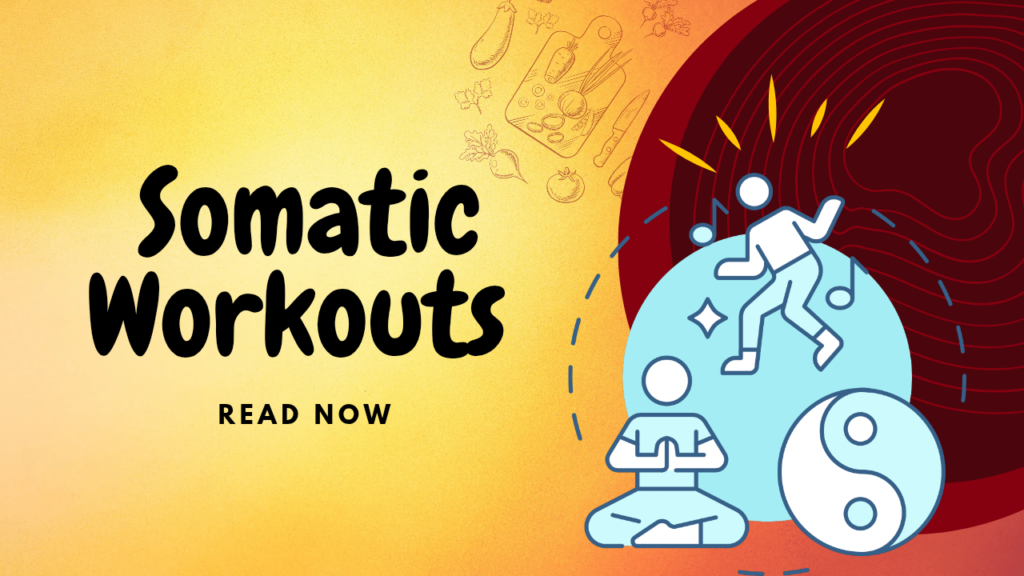
Introduction –
We live in our heads with racing thoughts, little time to sleep, endless to‑do lists, and constant digital reminders from our phones and other devices while our poor necks, backs, and limbs get shunted to the side.
Somatic workouts provide a gentle, effective way to bridge that chasm. You will learn to listen to your body’s wisdom, release tension, and develop a more profound sense of embodiment by attuning to sensations, breath, and subtle movement. In this guide, we’ll look at somatic exercises, why they’re essential, some of the science behind them, easy practices you can use, and how to begin incorporating them into your life. Let’s dive in!
What Are Somatic Workouts?
“Somatic” derives from the Greek word soma, meaning “the living body.” While traditional workouts target calories burned or muscle size, somatic workouts focus on internal experience. You will move slowly, pay attention to sensations, and see how your nervous system responds. It is often a mix of these practices.
Gentle, mindful movement (no jumping or heavy lifting)Breath awareness (using your breath to guide motion)Body scanning (noticing tension, warmth, or ease in different areas)Intentional pauses (pausing to sense before moving again) Where a cardio class might push you to “go harder,” a somatic session invites you to “go slower” and “feel deeper.” This mindful, exploratory approach helps you rediscover natural, efficient moving methods.
The Mind-Body Connection
Emotions Live in the Body. Anxiety might appear as a tight chest, and grief could be camping out in your throat or your shoulders. The Body Sends Signals. Pain or stiffness alerts us to an imbalance before a significant injury occurs.
Movement and the Nervous System. Speaking of pattern, gentle movement is excellent for calming down an overactive system, and blunt, jarring motion can exacerbate stress.
You develop communication between your brain and body as you become aware of how subtle changes in your posture, breath, and movement affect your mood and energy levels. This results in better posture, more balanced movement patterns, and greater comfort and ease in everyday life.
Benefits of Somatic Workouts
Why Somatics? There are plenty of reasons you might want to try somatics instead of or in addition to a more traditional routine. Here are the key benefits:
1. Reduced Chronic Tension and Pain Many people carry tension in their necks, shoulders, or lower backs without realizing it. Somatic movements gradually unwind these habits, carefully elongating tight regions to alleviate pain.
2. Improved Posture and Alignment You learn to stand and sit more effectively by feeling where your weight is on your heels versus your toes, the left hip versus the right. Improved alignment eases the burden on the joints.
3. Enhanced Body Awareness Somatics teaches you to pay attention to small sensations: the slight stretch in your hamstring, the softness behind your navel, the rhythm of your breath. This knowledge will assist you in catching the damaging patterns early on.
4. Stress Relief and Emotional Balance Slow, broad movements combined with conscious breathing and breath work calm the sympathetic nervous system (fight‑or‑flight) and open a deeper passage to the parasympathetic mode (rest‑and‑digest), leaving you feeling calmer and more resilient.
5. Greater Movement Variety Somatic workouts also typically incorporate spiralling, undulating, and gentle mobilizations of the joints, which is a movement you won’t find in a stereotypical gym class setting. These various shapes can create exceptional new flexibility and increase the range of movement or flex in surprising ways.
6. Accessibility for All Levels Because somatic exercises are gentle and can be adapted to anyone, they can benefit everyone, from recovering injury sufferers to elite athletes. You can do them in bed, sitting down or standing up, with or without props.
The Science Behind Somatic Workouts
Somatic approaches are supported by research in neuroscience and movement science.Neurogenic Tremor and Tension Release Techniques such as Somatic Experiencing employ tiny muscle tremors to help discharge excess tension from the nervous system. During the process, the reset button can select stress responses.Proprioceptive Feedback
Proprioception is how you perceive your position in space or your sense of body position. It is furthered by the gentle movement of the body through the range of motion, which activates the sensory receptors in the muscles and tendons.Motor Learning and Neuroplasticity
You create new “maps” in your brain for how to move efficiently, with slow, mindfully attentive, exploratory movements. In time, they overwrite old, harmful movement patterns.
Breath‑Movement Coupling Organizing breath with movement stimulates the vagus nerve, which considerably calms the nervous system and quells inflammation.
Conclusion
In a culture that venerates speed, output, and multitasking, somatic workouts invite us to slow down, tune in, and remember that our bodies are alive with intelligence. By moving mindfully, softly, and gently, you will not only relieve tension and correct posture but also learn to master one of the most excellent tools of emotion and stress regulation. Choose a simple exercise, take five minutes to play with it, and see what comes up for you. Over time, you will have a better relationship with your body, moving through life with ease, presence, and joy. Cheers to reconnecting to your body’s knowing as you move from one breath to the next.